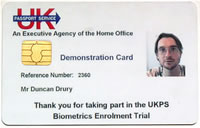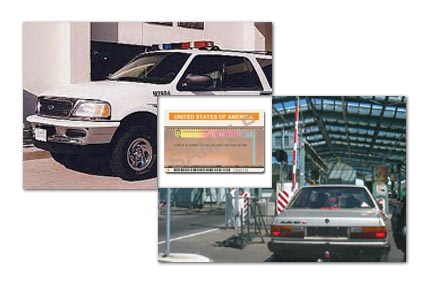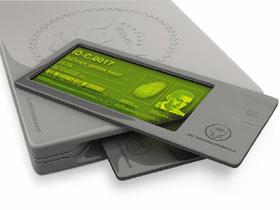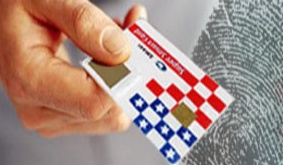| Menu |
Biometrics |
Rfid Chips |
National Id Cards |
Fascism, 666, And The Antichrist |
What's Next
|
|
National Id Cards - Does an increase in identification really lead to increased security or is it an invasion of our privacy?
The advance of identification technology biometrics, rfid chips, identity cards, surveillance, databases, dossiers threatens privacy, civil liberties, and related human interests. Since the terrorist attacks of September 11, 2001, demands for identification in the name of security have increased. A national ID represents a transfer of power from individuals to institutions, and that transfer may threaten our liberty, subject people to unwanted surveillance and a uniform, government-controlled identification system.
|
 UK's Trial Biometric Passport Card
UK's Trial Biometric Passport Card
|
|
 |
Optical Memory Cards
To facilitate local trade and provide convenience for inhabitants of border communities, the U.S. Department of State issues a B1/B2 Visa to Mexican citizens who wish to cross frequently into the U.S.A. This visa is issued in card form and is known as the Border Crossing Card (BCC). Following the 1997 introduction of the optical memory-based green card (the U.S. Permanent Resident Card) by the then U.S. Department of Homeland Security (DHS), the U.S. Department of State (DOS) selected the same optical card technology to enhance security on the U.S./Mexican border. In 1998, the optical memory-based BCC (or Laser Visa) was introduced and mandated for all new BCC applications and as a replacement for old, counterfeit prone documents. The BCC includes many of the same security features introduced for the Permanent Resident Card, such as micro images in the optical memory and the Embedded Hologram. Since the BCC's introduction in 1998, there has been no instance of a working counterfeit � a testament to the counterfeit resistance of optical memory technology.
| |
|
| |
Biometric Smart Cards
ActivCard, a specialist in IDentity Management software for remote access, single sign-on and digital ID card solutions, announced an expanded cooperation with its partner Precise Biometrics AB, developer and provider of world-leading and user-friendly biometric security solutions based on fingerprints, to deliver smart card-based identification (ID) badge solutions with biometric authentication. ActivCard has incorporated Precise Biometrics' technology for fingerprint matching on smart cards, "Precise Match-on-Card", to its "ActivCard Gold 2.2" software, the most successful and widely deployed smart ID card middleware platform available on the market today. By verifying the fingerprint that's on the card, the Precise Match-on-Card method guarantees that the reference biometric template (the user's identity) never leaves the card, so it is not subject to theft.
|
 Example Of A Biometric Smart Card
Example Of A Biometric Smart Card | |
|

|
The Super Smart Card
E-Smart Technologies is a leading provider of high technology
security systems that can be used to combat fraud and terrorism. E-Smart
products enable government
agencies and commercial enterprises to continuously and securely verify,
certify and manage identification and access of citizens, personnel, customers
and any other persons seeking physical or logical access.
E-Smart is the exclusive provider of the Biometric Verification Security System(TM) (BVS2)(TM), featuring the Super Smart Card(TM) for Asia and the US, which experts believe to be the world's only commercially available smartcard with a full on-card matching system for biometric ID verification.
|
|
|
National ID card - a disaster in the making
By Richard Forno and Bruce Schneier, May 2007
Six years into the "new normal" of terror alerts, identification checks, electronic surveillance, and increasing levels of secrecy-based security, the prospect of a national identification card needs serious public debate.
In March, the Department of Homeland Security released its long-awaited guidance document regarding national implementation of the Real ID program, as part of its post-9/11 national security initiatives. It is perhaps quite telling that despite bipartisan opposition, Real ID was buried in a 2005 "must-pass" military spending bill and enacted into law without public debate or congressional hearings.
DHS has maintained that the Real ID concept is not a national identification database. While it's true that the system is not a single database per se, this is a semantic dodge; according to the DHS document, Real ID will be a collaborative data-interchange environment built from a series of interlinking systems operated and administered by the states. In other words, to the Department of Homeland Security, it's not a single database because it's not a single system. But the functionality of a single database remains intact under the guise of a federated data-interchange environment.
The DHS document notes the "primary benefit of Real ID is to improve the security and lessen the vulnerability of federal buildings, nuclear facilities, and aircraft to terrorist attack." We know now that vulnerable cockpit doors were the primary security weakness contributing to 9/11, and reinforcing them was a long-overdue protective measure to prevent hijackings. But this still raises an interesting question: Are there really so many members of the American public just "dropping by" to visit a nuclear facility that it's become a primary reason for creating a national identification system? Are such visitors actually admitted?
DHS proposes guidelines for proving one's identity and residence when applying for a Real ID card. Yet while the department concedes it's a monumental task to prove one's domicile or residence, it leaves it up to the states to determine what documents would be adequate proof of residence--and even suggests that a utility bill or bank statement might be appropriate documentation. If so, a person could easily generate multiple proof-of-residence documents. Basing Real ID on such easy-to-forge documents obviates a large portion of what Real ID is supposed to accomplish.
Finally, and perhaps most importantly for Americans, the very last paragraph of the 160-page Real ID document deserves special attention. In a nod to states' rights advocates, DHS declares that states are free not to participate in the Real ID system if they choose--but any identification card issued by a state that does not meet Real ID criteria is to be clearly labeled as such, to include "bold lettering" or a "unique design" similar to how many states design driver's licenses for those under 21 years of age.
In its own guidance document, the department has proposed branding citizens not possessing a Real ID card in a manner that lets all who see their official state-issued identification know that they're "different," and perhaps potentially dangerous, according to standards established by the federal government. They would become stigmatized, branded, marked, ostracized, segregated. All in the name of protecting the homeland; no wonder this provision appears at the very end of the document.
One likely outcome of this DHS-proposed social segregation is that people presenting non-Real ID identification automatically will be presumed suspicious and perhaps subject to additional screening or surveillance to confirm their innocence at a bar, office building, airport or routine traffic stop. Such a situation would establish a new form of social segregation--an attempt to separate "us" from "them" in the age of counterterrorism and the new normal, where one is presumed suspicious until proven more suspicious.
Two other big-picture concerns about Real ID come to mind: Looking at the overall concept of a national identification database, and given existing data security controls in large distributed systems, one wonders how vulnerable this system-of-systems will be to data loss or identity theft resulting from unscrupulous employees, flawed technologies, external compromises or human error--even under the best of security conditions. And second, there is no clear guidance on the limits of how the Real ID database would be used. Other homeland security initiatives, such as the Patriot Act, have been used and applied--some say abused--for purposes far removed from anything related to homeland security. How can we ensure the same will not happen with Real ID?
As currently proposed, Real ID will fail for several reasons. From a technical and implementation perspective, there are serious questions about its operational abilities both to protect citizen information and resist attempts at circumvention by adversaries. Financially, the initial unfunded $11 billion cost, forced onto the states by the federal government, is excessive. And from a sociological perspective, Real ID will increase the potential for expanded personal surveillance and lay the foundation for a new form of class segregation in the name of protecting the homeland.
It's time to rethink some of the security decisions made during the emotional aftermath of 9/11 and determine whether they're still a good idea for homeland security and America. After all, if Real ID was such a well-conceived plan, Maine and 22 other states wouldn't be challenging it in their legislatures or rejecting the Real ID concept for any number of reasons. But they are.
|
|
| |

![]()